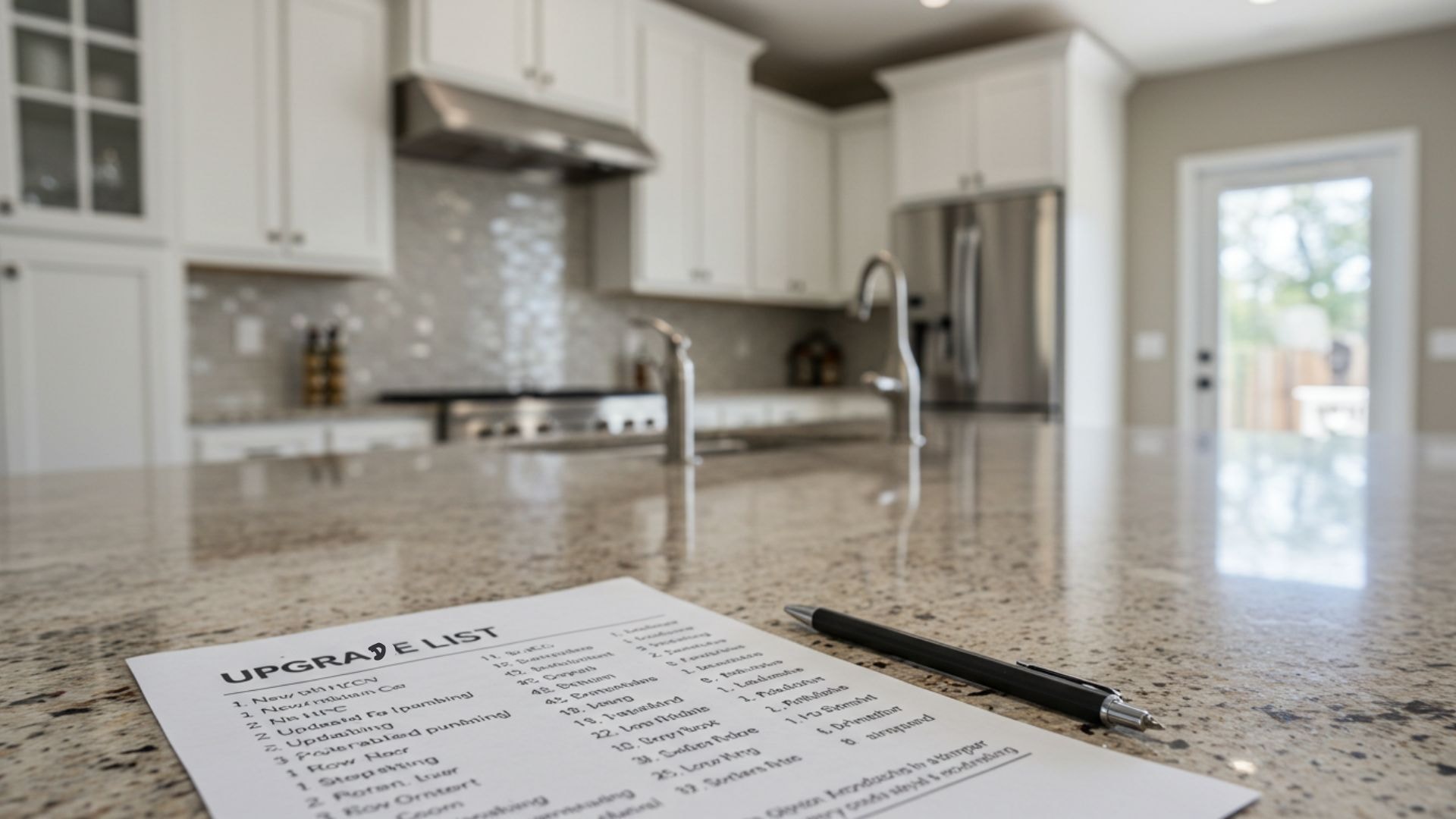
Flipping a House Checklist: Steps to Sell for Maximum Profit
You got a great deal on an investment property. You spent countless hours going back and forth with contractors and subcontractors. You’ve matched and picked out paint, the perfect paint. You’ve pulled teeth to get permits. All the new appliances are in and the final touches to the landscaping have been made. It’s time to cash in on all of your hard work and reap the rewards of your flip.
In 2024, the median profit per flipped property was approximately $73,500, though novice investors often earned less. With so much on the line, having a flipping-a-house checklist can make all the difference between maximizing your return and leaving money on the table. Overlooking key steps—like final inspections, market research, or ensuring compliance with local real estate regulations—can delay your sale or eat into your healthy profit margin.
To help you sell quickly and confidently, we’ve compiled the ultimate house-flipping checklist, covering everything from the renovation phase to the final walk-through. Use this complete guide to stay organized and avoid costly mistakes before your flipped property hits the local real estate market.
The Ultimate House-Flipping Checklist: Essential Steps for Real Estate Investors
Flipping houses is about strategic execution as much as renovations. To sell quickly and maximize your healthy profit margin, you need a well-organized house-flipping checklist. Successful real estate investors know that skipping key steps—like conducting thorough market research, preparing the right organizational documents, and ensuring high-quality marketing exposure—can lead to costly delays and missed opportunities.
Whether you’re working with a real estate agent or listing on the multiple listing service (MLS), having a clear, step-by-step plan ensures your investment property stands out in the local real estate market and attracts serious potential buyers.
Showcase Your Hard Work: Create a Detailed Upgrade List
The upgraded features of the renovated property might seem obvious to you, but never assume buyers—or even their real estate agent—will notice everything. This is especially true for high-cost, behind-the-scenes improvements like HVAC systems, roofing, electrical, and plumbing.

A well-documented house-flipping checklist should include all renovations, big and small, to highlight the true value of your investment property. Printing this list in a professional format and leaving it in a visible location, such as the kitchen counter, helps potential buyers appreciate the work that’s been done. To maximize exposure, provide a digital copy of your house-rehab checklist to your MLS broker or listing provider so it can be attached to your online listing—giving buyers all the details they need upfront.
Stay Transparent: Gather Required Disclosures
In many states, including Texas, sellers are legally required to provide a seller’s disclosure notice detailing the property’s condition. This document ensures that buyers are fully aware of any past repairs, ongoing issues, or potential concerns before committing to the purchase.
Failing to provide disclosures on time can create unnecessary delays—or worse, cause a deal to fall through entirely. Savvy real estate investors know that having these documents readily available, or even presenting them upfront, builds buyer confidence and minimizes last-minute renegotiations.
Whether you’re working with an agent or handling the process yourself, being proactive with disclosures streamlines the house-flipping process and keeps your investment property on track for a smooth closing.
Get Your Paperwork in Order: Organizational Documents Matter
If your investment property is owned by an LLC or another business entity, the title company will need to verify the correct ownership details before the sale can proceed. This means ensuring all necessary organizational documents—such as operating agreements, articles of incorporation, and authorization forms—are in place and up to date.
Too often, property investors face closing delays because they’re scrambling to locate these documents at the last minute. Avoid unnecessary headaches by gathering them in advance and confirming with your title company that everything is in order.
Pro-Tip: If your house-flipping project involves multiple or nested entities, be prepared to provide documentation for each one to prevent last-minute surprises.
Eliminate Surprises: Secure a Property Survey
A clean, usable survey is a crucial component of most real estate transactions, yet many sellers overlook its importance until the last minute. This document verifies property boundaries, easements, and encroachments—details that can impact financing, insurance, and even a buyer’s decision to move forward.
Providing a current survey upfront in the MLS gives buyers and their realtors added confidence in your investment property, reducing unnecessary back-and-forth during negotiations. If you don’t have an existing survey that meets requirements, ordering a new one early can prevent costly delays and help ensure a smooth closing. Since surveys can take weeks to process, planning ahead keeps your property inspection checklist on track and allows you to sell quickly.
First Impressions Count: Invest in Professional Photography
High-quality real estate photography directly impacts your bottom line. Listings with professional photos attract more potential buyers, generate higher offers, and sell 32% faster than those with low-quality images. Make sure your marketing plan includes professional photography. If your broker or MLS provider doesn’t offer it, insist on it. It’s a non-negotiable for serious house flippers looking to maximize returns.

Pro-Tip: Schedule your photoshoot before your investment property is officially listed. This ensures you’re ready to hit the market with stunning images as soon as the property is market-ready, helping you sell quickly and stay ahead of the competition.
Price It Right: Update Your Market Analysis
Even if you thoroughly researched your investment property before buying, market conditions can shift quickly. The local real estate market is constantly evolving—new listings, recent sales, and economic factors can all impact your house-flipping project’s potential profit. If the renovation process took longer than expected, your original pricing strategy may no longer align with current market trends.
To ensure you’re positioned competitively, update your market research by reviewing comparable sales and active listings. No matter how you analyze data, staying informed will help you set a price that attracts potential buyers while improving the likelihood of receiving the maximum purchase price.
Marketing That Sells: Have a Winning Strategy for Your Local Real Estate Market
At this stage, you should have a clear marketing plan for your flipped property—who your target buyers are and how you’ll reach them. The vast majority of potential buyers start their search online, so getting your listing on the MLS and major real estate websites is essential.
Ensure your preferred listing service provides the right tools to showcase your investment property effectively, including professional photography, listing syndication, and market insights. Timing is also key, so confirm that your service provider can move at the pace you need to sell quickly and capitalize on current market trends.
Final Steps to Sell Quickly and Profitably Without a Real Estate Agent
Flipping houses without a traditional real estate agent may seem overwhelming, but with the right strategy, it can be a faster, more profitable, and more streamlined process.

Balancing Costs
One of the biggest challenges real estate investors face is balancing rehab costs, holding costs, and market timing while trying to maximize profits. Traditional agents charge hefty commissions, cutting into your bottom line and adding another layer of complexity.
Fortunately, modern flat-fee, full-service platforms provide investors with all the tools needed to sell quickly, from MLS access to professional photography, contract management, and pricing insights—without the high commission costs.
Handling Negotiations and Paperwork
One of the most frustrating aspects of flipping houses is handling buyer negotiations, paperwork, and closing logistics—especially when dealing with multiple properties. Many sellers worry about missing critical steps, mispricing their property, or getting stuck in lengthy negotiations.
Following your flipping-a-house checklist ensures every detail is covered, but leveraging technology-driven solutions makes the process even smoother. Instead of relying on an agent’s schedule, these platforms let you stay in control—pricing your property based on real-time market research, managing offers digitally, and handling the closing process seamlessly.
Sell Smarter, Keep More Profits, and Flip With Confidence
By skipping the traditional agent route and opting for a flat-fee real estate service, you’re saving money while gaining efficiency and transparency. Whether you’re a seasoned real estate investor or tackling your first house-flipping project, using a full-service, commission-free platform means you get expert guidance when you need it, automated tools to stay organized, and marketing strategies that put your investment property in front of the right potential buyers.
At ListingSpark, we believe that selling a flipped property should be simple, cost-effective, and fully in your control. That’s why we offer a flat-fee, full-service platform that gives you everything a traditional real estate agent would—without the commission fees eating into your profit margin. From professional photography and MLS exposure to pricing insights, contract management, and expert support, we provide the tools and technology designed for real estate investing. Our streamlined process ensures you stay organized and get the best price for your flipped property with minimal hassle. Get started with ListingSpark today to take control of your house-flipping process and keep more of your hard-earned profits.
Related Posts
4 Strategies for Selling Your Home Without a Realtor
Texas is a great place for real estate investors and homeowners looking to sell. For one, you’re not required to have a real estate attorney present during a transaction. In fact, homeowners can sell their…
Is The House-Flipping Boom Over for Investors?
Over the past decade, house flipping has drawn in both seasoned real estate investors and ambitious newcomers, lured by the promise of turning fixer-uppers into fast profits. And why not? The idea of buying low,…
Is Now the Right Time to Sell Your Home in Texas? An In-Depth Analysis
Thinking about selling your home in Texas? You’re not alone. The Lone Star State’s housing market is shifting, and many homeowners are wondering whether now is the right time to make a move. The latest…




